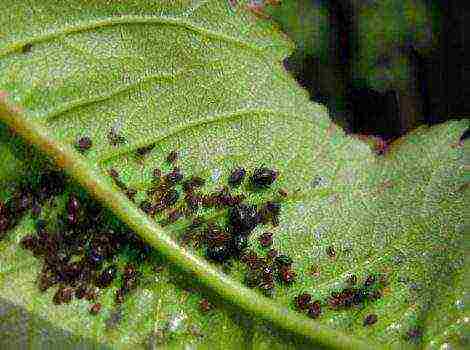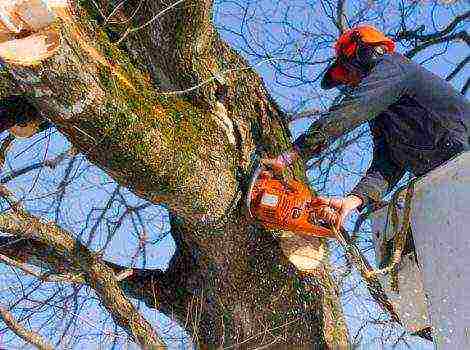Content
- 1 Walnut as a tree in the country
- 1.1 Moscow region, central Russia - where else can you plant and grow walnuts
- 1.2 How and when to plant and grow a tree from a seedling: conditions
- 1.3 Post-planting care: in spring, summer and autumn
- 1.4 How to properly care for the cultivation process: before ripening and after
- 1.5 Graft
- 1.6 Reproduction in the country
Walnut as a tree in the country
Usually this is a huge, by our standards, tree up to 25 meters to Greece it has a very indirect relationship: the fruits were brought from the south, and "Greece has everything." Surely, it also grows there, wild forms of this tree are common in Europe.
The tree looks impressive. A separately growing nut not only differs in height - its crown also reaches a diameter of 20 meters.
By European standards, he is a long-liver (second after oak) - specimens of 300-400-year-old trees are often found.
The development of the tree begins with the formation of a powerful taproot, which reaches 1.5 meters in depth at the 5th year and 3.5 meters by the age of 20.
Horizontal ones do not grow immediately - they are formed after the core, located in the surface layer of the soil at a depth of 20-50 centimeters.
The tree begins to bear fruit after 10 years of life, and from the age of 30-40, the time of full fruiting comes.
But such cases are rare, only a tree 150-170 years old is capable of such a harvest. Usually an adult tree 25-40 years old in Moldova gives 1500-2000 fruits or 2000-2500 in the Crimea.
Moscow region, central Russia - where else can you plant and grow walnuts
They are found in the European part from the foothills of the Caucasus to St. Petersburgwhere the northernmost nuts in Russia grow. But these are isolated cases, exceptions that only confirm the rule.
These trees do not freeze completely, but they also do not grow at full strength.
The main factor that determines the possibility of growing this southern tree is not at all the winter subzero temperatures. The sum of average daily temperatures above 10 degrees is taken into account. It cannot be less than 190 C.
The best winter hardiness was shown by hybrids of Manchurian with walnuts.
When planting even the best seed material brought from the south, adaptation to the cold climate does not occur - such trees freeze regularly and practically do not bear fruit.
Varieties from places with a humid warm climate are completely unsuitable for cultivation. (west and south of Ukraine, the Black Sea coast of the Caucasus).
Only nuts from eastern Ukraine, the mountains of Central Asia or the Caucasus are successfully adapting to the new conditions of central Russia.
Moreover, it is better to grow a nut from a bone on your own - an imported seedling (even from the indicated regions) will be significantly inferior in endurance and adaptability to new conditions.
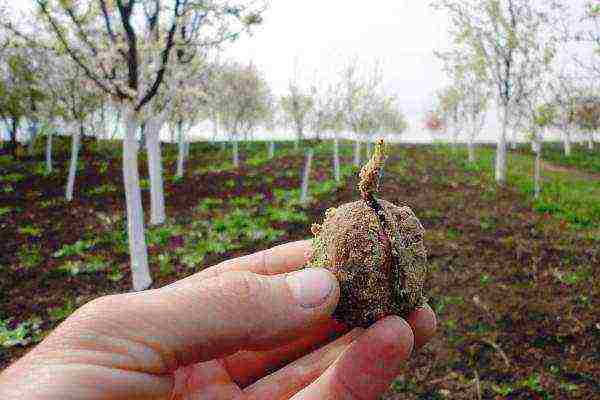
How and when to plant and grow a tree from a seedling: conditions
It must be immediately planted in a permanent place.... It is unrealistic to transplant a 5-year-old tree. Therefore, you need to decide to take into account all the factors and calculate the consequences.
A vigorous tree is capable of forming a dense shade over an area of approximately 100 sq. M. You will have to delete this area from circulation - under a walnut, there is little that can bear fruit (the strong suppressing effect of the biofield of a huge tree affects).
We choose a place for planting at the edge of the gardenso as not to shade other trees. The nut is very unpretentious to soils, although it prefers loose sandy-stony soil.
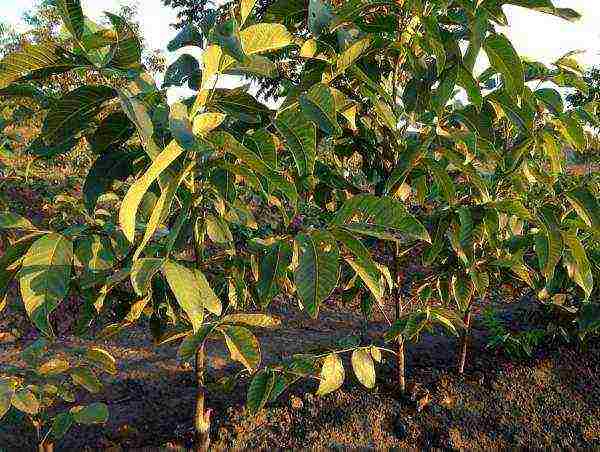
The planting hole is dug so that under the roots there is a layer of stones of at least 25 centimeters.
The bottom of the planting pit must be half filled with construction waste (broken brick, pieces of cement, crushed stone) - this technique allows you to shift the flowering time of the tree by 1-2 weeks (the stones slowly warm up, the nut starts growing a little later, skipping the period of frost).
Half a bucket of ash, compost or humus is introduced into the pit... The soil should not be too fertile, the nut will grow intensively and will not have time to prepare for winter.
A seedling for planting must be taken only from a trusted seller, otherwise you will not get anything except frostbitten branches of a southern tree, you probably will not wait for a harvest.
It is believed that a nut planted with his own hand from a bone will grow into a tree practically adapted to new conditions, which will develop successfully.
Seeds are planted in the fall directly into the ground to a depth of 7-10 cm... It is advisable to lay in the soil sideways at the seam. Spring planting requires 2-3 months of stratification in wet sand.
Special care for the seedlings is not required - in the middle lane even the nut has no pests.
How to plant an annual nut seedling:
Post-planting care: in spring, summer and autumn
How to care? Walnuts may need watering only in spring and early summer.when there is an intensive growth of green mass. Usually, the soil reserve of winter moisture is enough for the tree.
Only young trees up to 5-7 years old are watered, if it is completely dry.
The pivotal root system of the southern tree is adapted to find water in the lower horizons. After 10 years of age, you should generally forget about watering the walnut.
For him, excess moisture threatens to grow too actively, to the detriment of the ripening and preparation of wood for winter. Freezing after a wet summer is guaranteed.
In addition to stopping watering, you need to take care of preparing the root system for winter. Therefore, trunks must be mulched with any organic matter or compost:
- in summer - to preserve moisture;
- in the fall - to protect the topsoil from freezing.
It is useful to cover the stem up to a height of about 1 m with spruce branches or wrap it with newspapers in several layers (after the first frost). This will help you survive -40 degrees and below.
Such shelter is necessary only in the early years. - the wood must be naturally hardened.
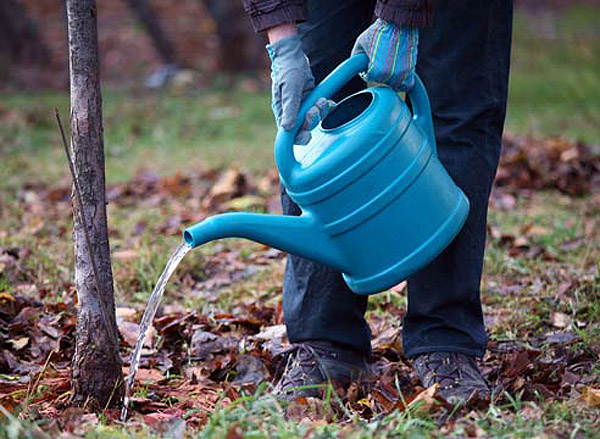
How to properly care for the cultivation process: before ripening and after
Like all fruit crops, walnut needs periodic feeding.
In the spring, nitrogen fertilizers are applied, in the second half of summer - only potash and phosphorus fertilizers, which are responsible for preparing the tree for winter and laying fruit buds for the next harvest.
On cultivated soil, nitrogen can not be fed at all, and phosphorus and potash fertilizers can be applied (in terms of the active ingredient) at 10 g / m2.
Practice shows that the rule applies to all cases when the nut does not grow on obvious stones and clay.
What is especially pleasing - in the middle lane, the walnut has no natural enemies... It has already been said that flies and mosquitoes fly around it.
Moreover, a very effective remedy against aphids and various caterpillars can be prepared from the leaves of the walnut, which is successfully used in Ukraine.
Home remedy absolutely harmless to humans allows you to process trees and bushes with fruit and berry ovaries.
Graft
Unfortunately, walnut cuttings do not take root - propagation occurs only by seeds.
Vaccination is carried out in cases where:
- there is a seedling of probably winter-hardy Manchurian walnut, for which -40 in winter is not a problem;
- the planted variety did not live up to expectations - there was an opportunity to re-graft it.
Annual seedlings are grafted into a split and grown under control in a greenhouse to a presentation.
Young trees that have already produced the first few nuts can be re-grafted by the type of "budding with an eye" - only the bark is removed from the bud in the form of a half-tube (the method is called that) and is combined with the same cut on the rootstock.
Until complete healing, the vaccination site is tied with a film.
The result of grafting an adult walnut tree:
Reproduction in the country
The main method of obtaining seedlings is growing from seeds... To simplify the process, the nuts are planted in the fall to a depth of about 10 centimeters without additional processing. It is believed that it is best to lay them sideways at the seam.
Walnut is renewed by pneumatic shoots in just a year or two. These trees are able to bear fruit literally in the second year, and at 10 - already a significant harvest.

It turns out that walnuts can be successfully planted and grown in a country house in the middle lane, in the Moscow region. It is enough just to follow simple rules:
- the right choice of place;
- seedling - only zoned;
- obligatory mulching of the trunk circle;
- shelter of the trunk from frost in the first years of life.
All this is within the power of most gardeners.... Choose a sunny spot protected from cold winds - the walnut will thank you.
